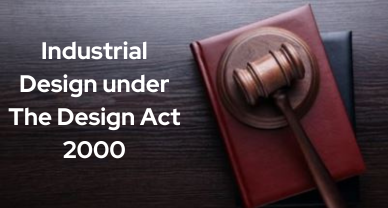Salient Features Of The Designs Act, 2000
The Designs Act is an act that protects one of the most significant Intellectual Property Rights of a person. With the proliferation of people realizing the importance of such rights and registering for the protection of various kinds of marks, it could not be possible to include the relevant provisions of all the rights in one statute. Therefore, many acts govern several IPRs one of which includes the Designs Act,2000. This blog explains all its salient features.
[Picture Credit: Shutterstock]
The vast and ever-progressing arena of Intellectual Property Rights is impossible to be governed by merely one statute. The various types of IPR need to protect from all possibilities that may cause a violation. Therefore, there are separate acts for each right. The Designs Act, 2000 is one such act.
Design is a type of IPR that protects any composition be it two-dimensional or three-dimensional of lines, patterns, shapes, or colors. They add attractiveness to the product by making it unique and distinctive ultimately leading to alluring potential customers. A design may also be linked to a company’s reputation and goodwill.
ORIGIN
The Designs Act came into effect on 25th May 2000.
The act is built on a first-to-file, first-to-get approach, which means that the inventor or developer of a design should file a registration application as soon as possible to prevent others from claiming rights to that design.
The need for design protection was recognized in India in the 18th century, and the Patterns and Design Protection Act was enacted in 1872. For a limited period, this Act granted the inventors the exclusive right to make and sell their designs.
Since then, several other acts came up as well, but finally, in 2000 the designs act was established.
SALIENT FEATURES
- Sections and Schedules– The Designs act is inclusive and vast. The Designs Act has 9 schedules and 48 sections.
- Objective – Its major goal is to prevent innovative or original designs from being copied and causing financial harm to the owner.
- Requirements under the design act:
- The design under it should be novel and original- If a design has been previously registered under the act, it will not be valid for registration again. It should possess a unique and distinctive quality.
- A prior publication is off-limits- There should have been no other such design that had already been exposed and revealed to the public before.
- Morality- The design should not be opposed to the morals of the law or the society.
- Application- An application must be made for the said design for its final publication as the first step of registration.
In Bharat Glass Tube Limited v. Gopal Glass Works Limited on 1 May 2008, under the Designs Act of 2000, the respondent had registered their designs for diamond-shaped glass sheets. As a result, the Respondent obtained exclusive rights to produce and distribute the glass sheets in the design that it had registered. The engraved rollers used to create the graphics on the glass sheets were developed by Dornbusch Gravuren GMBH (hereafter referred to as the “German Company”), which had licensed all Indian rights to the respondent.
Appellant and its affiliate, IAG Co. Ltd., began mimicking the aforementioned registered designs. As a result, Respondent was forced to file a lawsuit in the District Court of Mehsana, Gujarat, against the Appellant and IAG Co. Ltd. In the same suit, the respondent also obtained a restraint order.
The appellant thus applied Section 19 of the Designs Act, 2000 before the Controller of Patents & Designs for cancellation of registration of Design No. 190336 in the name of the Respondent.
However, it was seen that the appellant has presented no evidence before the Assistant Controller or any other forum to indicate that this exact design, which has been copied on the glass sheet, was made elsewhere in the market in India or the United Kingdom.
Thus, the Supreme Court found no merit in the appeal and it was dismissed with costs of Rs. 50,000/-.
- Locarno Classification– The Locarno categorization, which is based only on the subject matter of design, was introduced under the Act of 2000. There are functional classes under which a specific design falls.
- Registration– Schedule 2 of the Designs Act defines the procedure of registration. A design must be registered to receive any rights or protection by the act against infringement. Under section 4, there are some designs that are prohibited to be registered on the conditions that they:
- Are not original
- before the filing date, or, if applicable, the priority date of the application for registration, has been made public anywhere in India or any other country by publishing in tangible form, use, or any other means
- Are not distinctive from other designs
- Comprises on the immoral matter.
It is necessary to possess a certificate of registration after the procedure is done.
- Copyright in registered designs– The registered design holds a validity period of 10 years, which can be renewed for 5 years after the date of expiration. The appeal for renewal along can be submitted during the 10 years of the registration.
- Restoration of a lapsed design– A design that ceases to have effect as a result of failure to pay the fee for the extension of copyright under subsection (2) of section 11, the proprietor of such design or his legal representative, and where the design was held jointly by two or more persons, may, with the permission of the Controller, make an application for the restoration of the design within one year of the date on which the design ceased to have an effect.
- Cancellation of design– Any person interested may file a petition with the Controller for the cancellation of a design’s registration at any time after the design’s registration on any of the grounds of it having already been previously registered in India or any other country, it being not a new or original, the design is not registrable unregistered.
- Piracy of registered designs– The Designs Act of 2000 states that any false or evident replication of a registered design without the proprietor’s authorization is illegal, as is the importation of such material that closely resembles a registered design. The section expressly states that in a civil case, the compensation payable for infringement of a single registered design shall not exceed Rs. 50,000/-. Because the amount of compensation that can be paid is contractually fixed, it is a valid reason to seek an interim injunction even before the trial begins.
- Power Of controller– The controller may possess the civil powers of receiving evidence, administering oaths, enforcing the attendance of witnesses, compelling the discovery and production of documents, issuing commissions for the examination of witnesses, and granting rewards such award shall be actionable in any court having jurisdiction as a decree of that court.
If this Act declares that an appeal from the Controller to the High Court is permissible, the appeal must be filed within three months of the date of the Controller’s order.
- Appeal to high courts– Where the high courts have jurisdiction, the Act authorizes district courts to transfer cases to them. It is only feasible in circumstances when someone is contesting the legitimacy of a registration.
CONCLUSION
The Designs Act has been made with quite a careful consideration of the possible forms of violation that case takes place, as well as a defined procedure of the registration, it also makes sure that the Controller doesn’t misuse his powers by providing clear and specific provisions of the extent of his powers. This act thus can help secure the designs of a product and all the goodwill and additional benefits it comes along with.
Author: Gurveen Kaur – a intern at IP And Legal Filings, in case of any queries please write back us via email at support@ipandlegalfilings.com.




